Structural, Electronic and Magnetic Properties of a Few Nanometer-Thick Superconducting NdBa2Cu3O7 Films
Abstract
1. Introduction
2. Materials and Methods
3. Results and Discussion
4. Conclusions
Author Contributions
Funding
Acknowledgments
Conflicts of Interest
References
- Keimer, B.; Kivelson, S.A.; Norman, M.R.; Uchida, S.; Zaanen, J. From quantum matter to high-temperature superconductivity in copper oxides. Nature 2015, 518, 179–186. [Google Scholar] [CrossRef]
- Bednorz, J.G.; Müller, K.A. Possible highTc superconductivity in the Ba-La-Cu-O system. Zeitschrift für Physik B Condensed Matter 1986, 64, 189–193. [Google Scholar] [CrossRef]
- Triscone, J.M.; Karkut, M.G.; Antognazza, L.; Brunner, O.; Fischer, O. Y-Ba-Cu-O/Dy-Ba-Cu-O superlattices: A first step towards the artificial construction of high-Tc superconductors. Phys. Rev. Lett. 1989, 63, 1016–1019. [Google Scholar] [CrossRef]
- Salluzzo, M.; De Luca, G.; Marrè, D.; Putti, M.; Tropeano, M.; Scotti di Uccio, U.; Vaglio, R. Thickness effect on the structure and superconductivity of Nd1.2Ba1.8Cu3Oz epitaxial films. Phys. Rev. B 2005, 72, 134521. [Google Scholar] [CrossRef]
- You, L.X.; Yurgens, A.; Winkler, D.; Lin, C.T.; Liang, B. Superconducting properties of ultrathin Bi2Sr2CaCu2O8+x single crystals. J. Appl. Phys. 2005, 98, 033913. [Google Scholar] [CrossRef]
- Salluzzo, M.; De Luca, G.M.; Di Capua, R.; Gambardella, A.; Ristic, Z.; Vaglio, R. Electric field effect and superconducting–insulating transition in ‘123’ cuprate superconductors. Supercond. Sci. Technol. 2009, 22, 034010. [Google Scholar] [CrossRef]
- Arpaia, R.; Golubev, D.; Baghdadi, R.; Ciancio, R.; Dražić, G.; Orgiani, P.; Montemurro, D.; Bauch, T.; Lombardi, F. Transport properties of ultrathin YBa2Cu3O7-δ nanowires: A route to single-photon detection. Phys. Rev. B 2017, 96, 064525. [Google Scholar] [CrossRef]
- Ghiringhelli, G.; Brookes, N.B.; Annese, E.; Berger, H.; Dallera, C.; Grioni, M.; Perfetti, L.; Tagliaferri, A.; Braicovich, L. Low Energy Electronic Excitations in the Layered Cuprates Studied by Copper L3 Resonant Inelastic X-Ray Scattering. Phys. Rev. Lett. 2004, 92, 117406. [Google Scholar] [CrossRef]
- Ghiringhelli, G.; Piazzalunga, A.; Wang, X.; Bendounan, A.; Berger, H.; Bottegoni, F.; Christensen, N.; Dallera, C.; Grioni, M.; Grivel, J.; et al. Crystal field and low energy excitations measured by high resolution RIXS at the L3 edge of Cu, Ni and Mn. Eur. Phys. J. Spec. Top. 2009, 169, 199–205. [Google Scholar] [CrossRef]
- Moretti Sala, M.; Bisogni, V.; Aruta, C.; Balestrino, G.; Berger, H.; Brookes, N.B.; De Luca, G.M.; Di Castro, D.; Grioni, M.; Guarise, M.; et al. Energy and symmetry of dd excitations in undoped layered cuprates measured by Cu L3 resonant inelastic x-ray scattering. New J. Phys. 2011, 13, 043026. [Google Scholar] [CrossRef]
- Braicovich, L.; van den Brink, J.; Bisogni, V.; Moretti Sala, M.; Ament, L.J.P.; Brookes, N.B.; De Luca, G.M.; Salluzzo, M.; Schmitt, T.; Strocov, V.N.; et al. Magnetic Excitations and Phase Separation in the Underdoped La2-xSrxCuO4 Superconductor Measured by Resonant Inelastic X-Ray Scattering. Phys. Rev. Lett. 2010, 104, 077002. [Google Scholar] [CrossRef]
- Le Tacon, M.; Ghiringhelli, G.; Chaloupka, J.; Moretti Sala, M.; Hinkov, V.; Haverkort, M.W.; Minola, M.; Bakr, M.; Zhou, K.J.; Blanco-Canosa, S.; et al. Intense paramagnon excitations in a large family of high-temperature superconductors. Nat. Phys. 2011, 7, 725–730. [Google Scholar] [CrossRef]
- Dean, M.P.M.; Dellea, G.; Springell, R.S.; Yakhou-Harris, F.; Kummer, K.; Brookes, N.B.; Liu, X.; Sun, Y.J.; Strle, J.; Schmitt, T.; et al. Persistence of magnetic excitations in La2-xSrxCuO4 from the undoped insulator to the heavily overdoped non-superconducting metal. Nat. Mater. 2013, 12, 1019–1023. [Google Scholar] [CrossRef]
- Ivashko, O.; Shaik, N.E.; Lu, X.; Fatuzzo, C.G.; Dantz, M.; Freeman, P.G.; McNally, D.E.; Destraz, D.; Christensen, N.B.; Kurosawa, T.; et al. Damped spin excitations in a doped cuprate superconductor with orbital hybridization. Phys. Rev. B 2017, 95, 214508. [Google Scholar] [CrossRef]
- Peng, Y.Y.; Huang, E.W.; Fumagalli, R.; Minola, M.; Wang, Y.; Sun, X.; Ding, Y.; Kummer, K.; Zhou, X.J.; Brookes, N.B.; et al. Dispersion, damping, and intensity of spin excitations in the monolayer (Bi,Pb)2(Sr,La)2CuO6+δ cuprate superconductor family. Phys. Rev. B 2018, 98, 144507. [Google Scholar] [CrossRef]
- Dean, M.P.M.; Springell, R.S.; Monney, C.; Zhou, K.J.; Pereiro, J.; Bozovic, I.; Dalla Piazza, B.; Rønnow, H.M.; Morenzoni, E.; van den Brink, J.; et al. Spin excitations in a single La2CuO4 layer. Nat. Mater. 2012, 11, 850–854. [Google Scholar] [CrossRef]
- Srot, V.; Wang, Y.; Minola, M.; Salluzzo, M.; De Luca, G.M.; Keimer, B.; van Aken, P.A. Direct Visualization and Image Simulations of Oxygen Sublattice Occupancy in Thin Cuprate Films. Microsc. Microanal. 2018, 24, 76–77. [Google Scholar] [CrossRef]
- Srot, V.; Wang, Y.; Minola, M.; Salzberger, U.; Salluzzo, M.; De Luca, G.M.; Keimer, B.; van Aken, P.A. Combined imaging and analytical STEM of ultra-thin cuprate films. Microsc. Microanal. 2019, 25, 1750–1751. [Google Scholar] [CrossRef]
- Srot, V.; Wang, Y.; Salzberger, U.; Fenk, B.; Kelsch, M.; Minola, M.; Salluzzo, M.; De Luca, G.M.; Keimer, B.; van Aken, P.A.; et al. Improved sample preparation of beam-sensitive ultra-thin cuprate films. Microsc. Microanal. 2019, 25, 686–687. [Google Scholar] [CrossRef]
- Strocov, V.; Schmitt, T.; Flechsig, U.; Schmidt, T.; Imhof, A.; Chen, Q.; Raabe, J.; Betemps, R.; Zimoch, D.; Krempasky, J.; et al. High-resolution soft X-ray beamline ADRESS at the Swiss Light Source for resonant inelastic X-ray scattering and angle-resolved photoelectron spectroscopies. J. Synchrotron Radiat. 2010, 17, 631–643. [Google Scholar] [CrossRef]
- Ghiringhelli, G.; Piazzalunga, A.; Dallera, C.; Trezzi, G.; Braicovich, L.; Schmitt, T.; Strocov, V.N.; Betemps, R.; Patthey, L.; Wang, X.; et al. SAXES, a high resolution spectrometer for resonant x-ray emission in the 400–1600 eV energy range. Rev. Sci. Instrum. 2006, 77, 113108. [Google Scholar] [CrossRef]
- Fumagalli, R.; Braicovich, L.; Minola, M.; Peng, Y.Y.; Kummer, K.; Betto, D.; Rossi, M.; Lefrançois, E.; Morawe, C.; Salluzzo, M.; et al. Polarization-resolved Cu L3-edge resonant inelastic x-ray scattering of orbital and spin excitations in NdBa2Cu3O7-δ. Phys. Rev. B 2019, 99, 134517. [Google Scholar] [CrossRef]
- Benjamin, D.; Klich, I.; Demler, E. Single-Band Model of Resonant Inelastic X-Ray Scattering by Quasiparticles in High-Tc Cuprate Superconductors. Phys. Rev. Lett. 2014, 112, 247002. [Google Scholar] [CrossRef] [PubMed]
- Le Tacon, M.; Minola, M.; Peets, D.C.; Moretti Sala, M.; Blanco-Canosa, S.; Hinkov, V.; Liang, R.; Bonn, D.A.; Hardy, W.N.; Lin, C.T.; et al. Dispersive spin excitations in highly overdoped cuprates revealed by resonant inelastic x-ray scattering. Phys. Rev. B 2013, 88, 020501. [Google Scholar] [CrossRef]
- Peng, Y.Y.; Dellea, G.; Minola, M.; Conni, M.; Amorese, A.; Di Castro, D.; De Luca, G.M.; Kummer, K.; Salluzzo, M.; Sun, X.; et al. Influence of apical oxygen on the extent of in-plane exchange interaction in cuprate superconductors. Nat. Phys. 2017, 13, 1201–1206. [Google Scholar] [CrossRef]
- Minola, M.; Hozoi, L.; Di Castro, D.; Felici, R.; Moretti Sala, M.; Tebano, A.; Balestrino, G.; Ghiringhelli, G.; van den Brink, J.; Braicovich, L. Measurement of the effect of lattice strain on magnetic interactions and orbital splitting in CaCuO2 using resonant inelastic x-ray scattering. Phys. Rev. B 2013, 87, 085124. [Google Scholar] [CrossRef]
- Ivashko, O.; Horio, M.; Wan, W.; Christensen, N.B.; McNally, D.E.; Paris, E.; Tseng, Y.; Shaik, N.E.; Rønnow, H.M.; Wei, H.I.; et al. Strain-engineering Mott-insulating La2CuO4. Nat. Commun. 2019, 10, 786. [Google Scholar] [CrossRef]
- Minola, M.; Dellea, G.; Gretarsson, H.; Peng, Y.Y.; Lu, Y.; Porras, J.; Loew, T.; Yakhou, F.; Brookes, N.B.; Huang, Y.B.; et al. Collective Nature of Spin Excitations in Superconducting Cuprates Probed by Resonant Inelastic X-Ray Scattering. Phys. Rev. Lett. 2015, 114, 217003. [Google Scholar] [CrossRef]
- Scalapino, D.J. A common thread: The pairing interaction for unconventional superconductors. Rev. Mod. Phys. 2012, 84, 1383–1417. [Google Scholar] [CrossRef]
- Jiang, D.; Hu, T.; You, L.; Li, Q.; Li, A.; Wang, H.; Mu, G.; Chen, Z.; Zhang, H.; Yu, G.; et al. High-Tc superconductivity in ultrathin Bi2Sr2CaCu2O8+x down to half-unit-cell thickness by protection with graphene. Nat. Commun. 2014, 5, 5708. [Google Scholar] [CrossRef]
- Yu, Y.; Ma, L.; Cai, P.; Zhong, R.; Ye, C.; Shen, J.; Gu, G.D.; Chen, X.H.; Zhang, Y. High-temperature superconductivity in monolayer Bi2Sr2CaCu2O8+d. Nature 2019, 575, 156–163. [Google Scholar] [CrossRef] [PubMed]
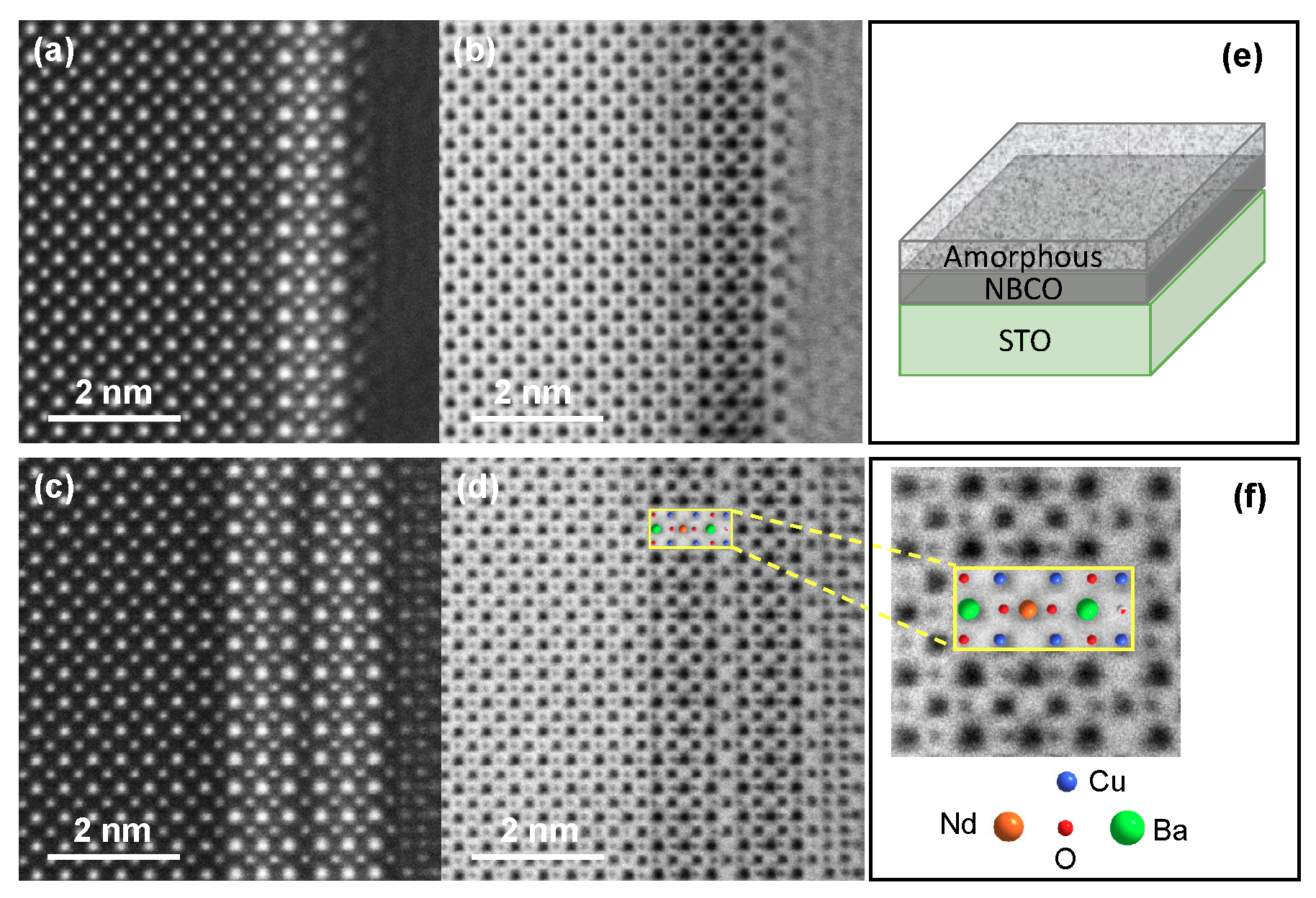
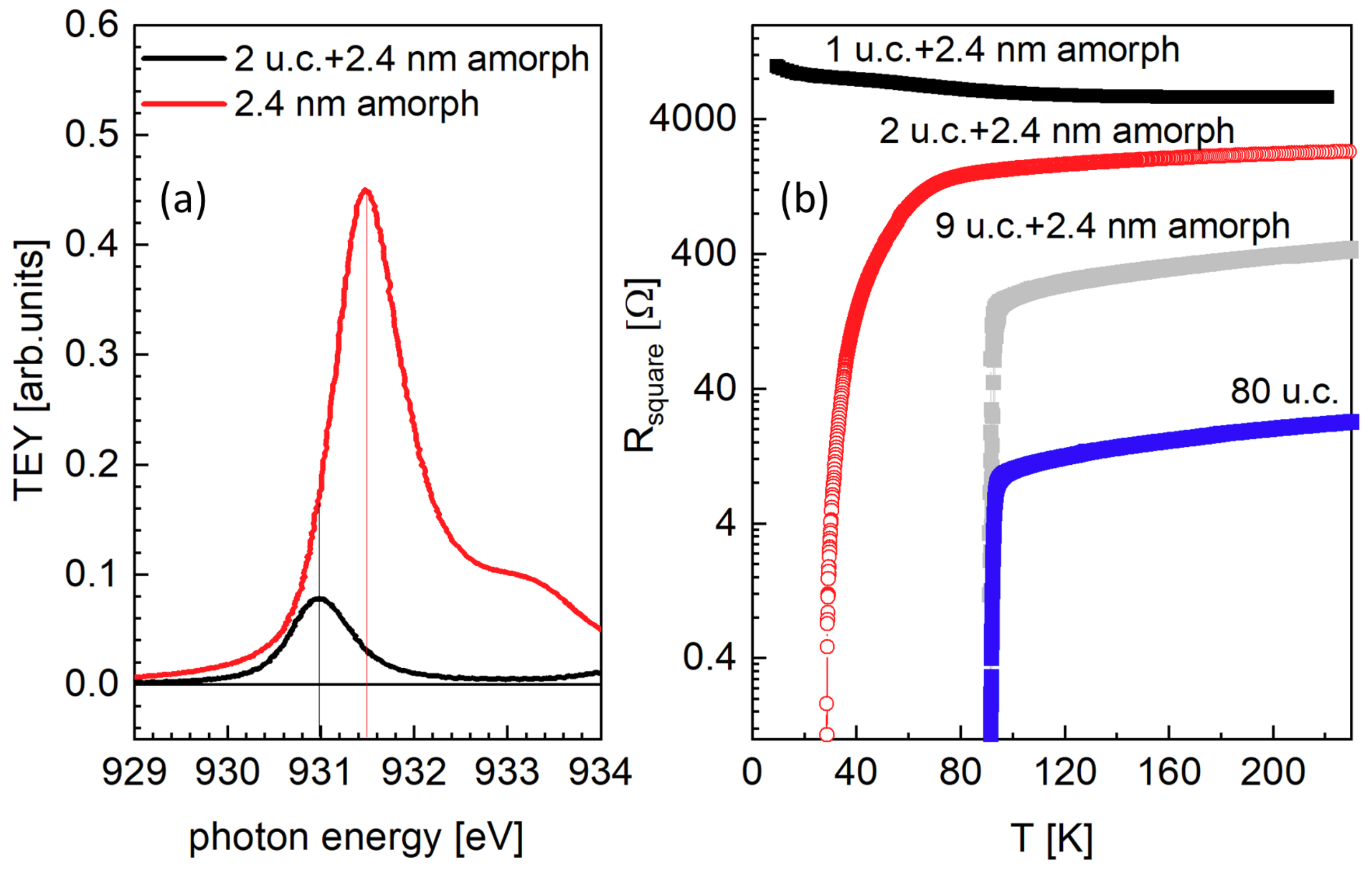
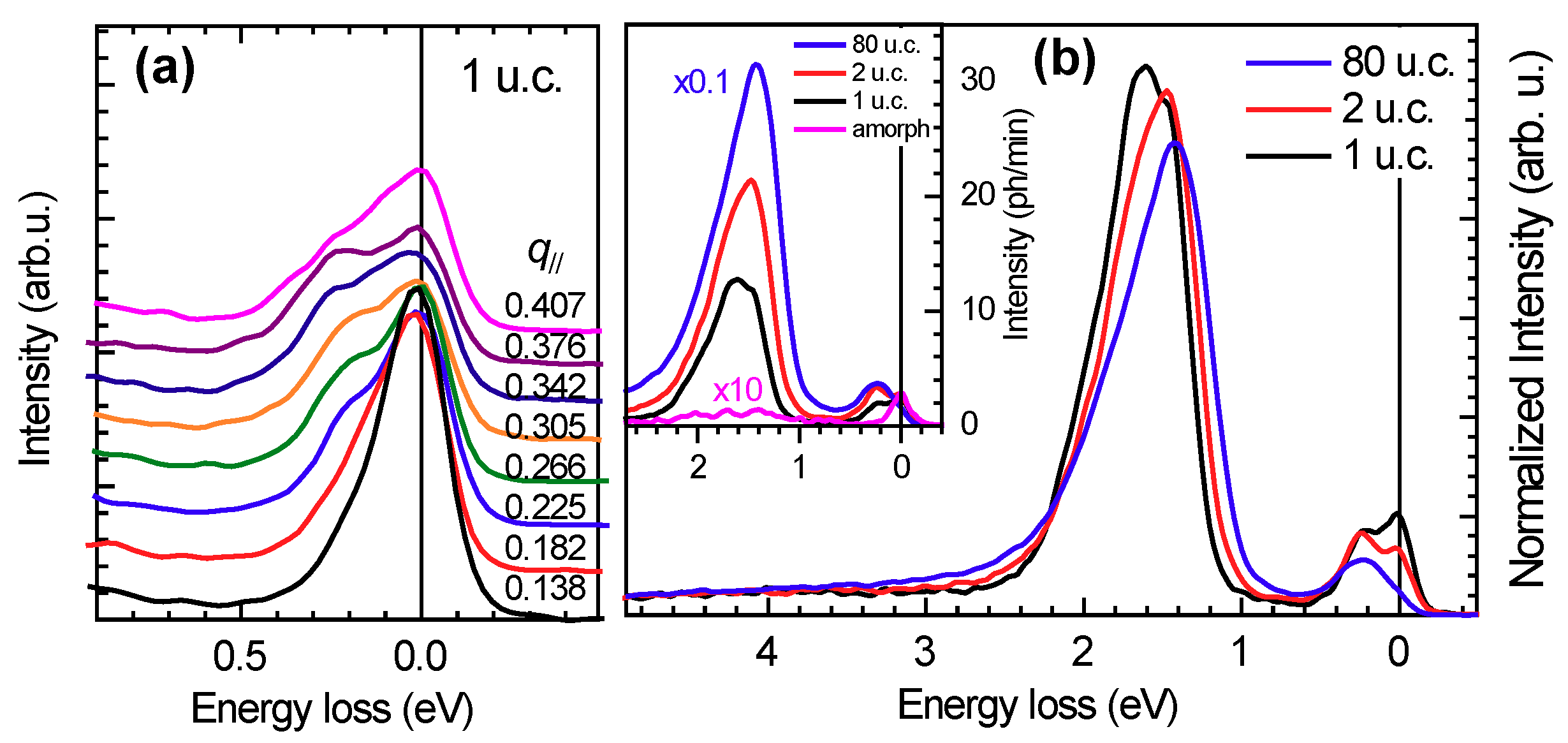
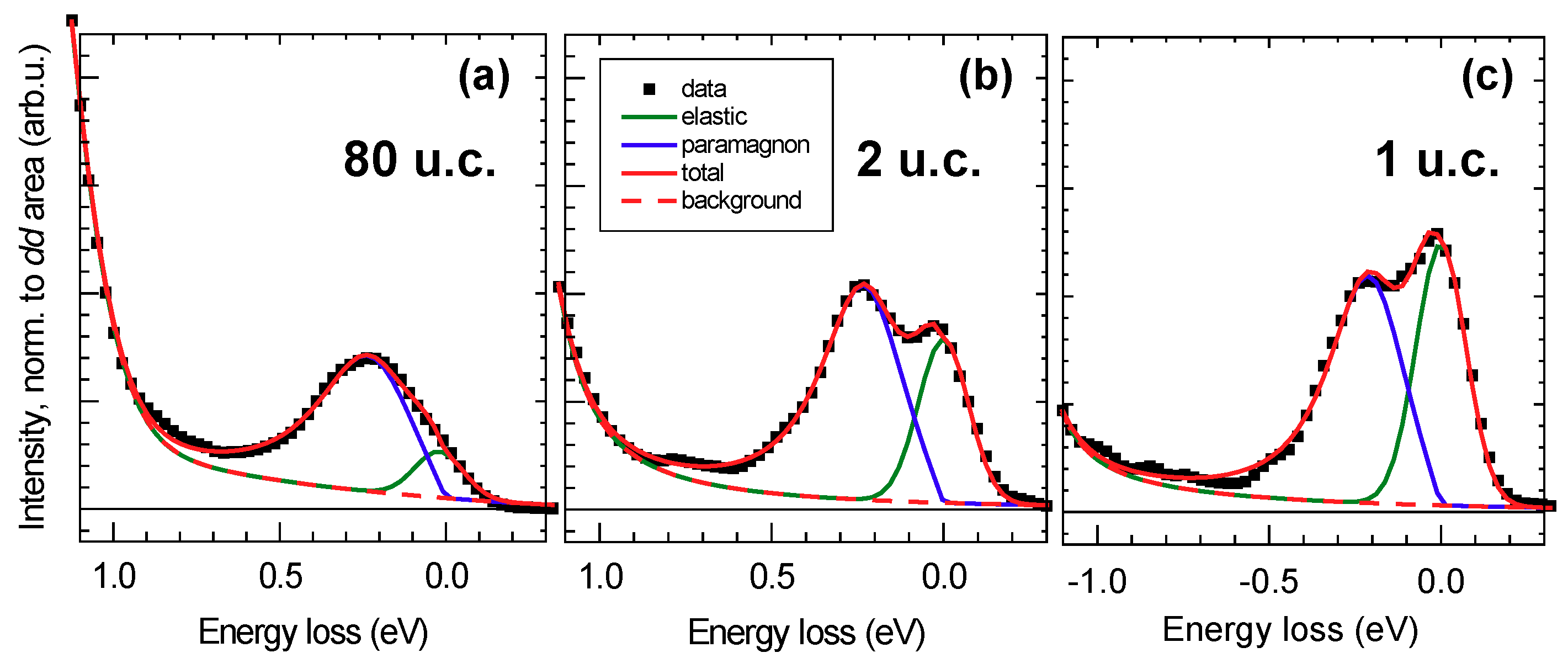
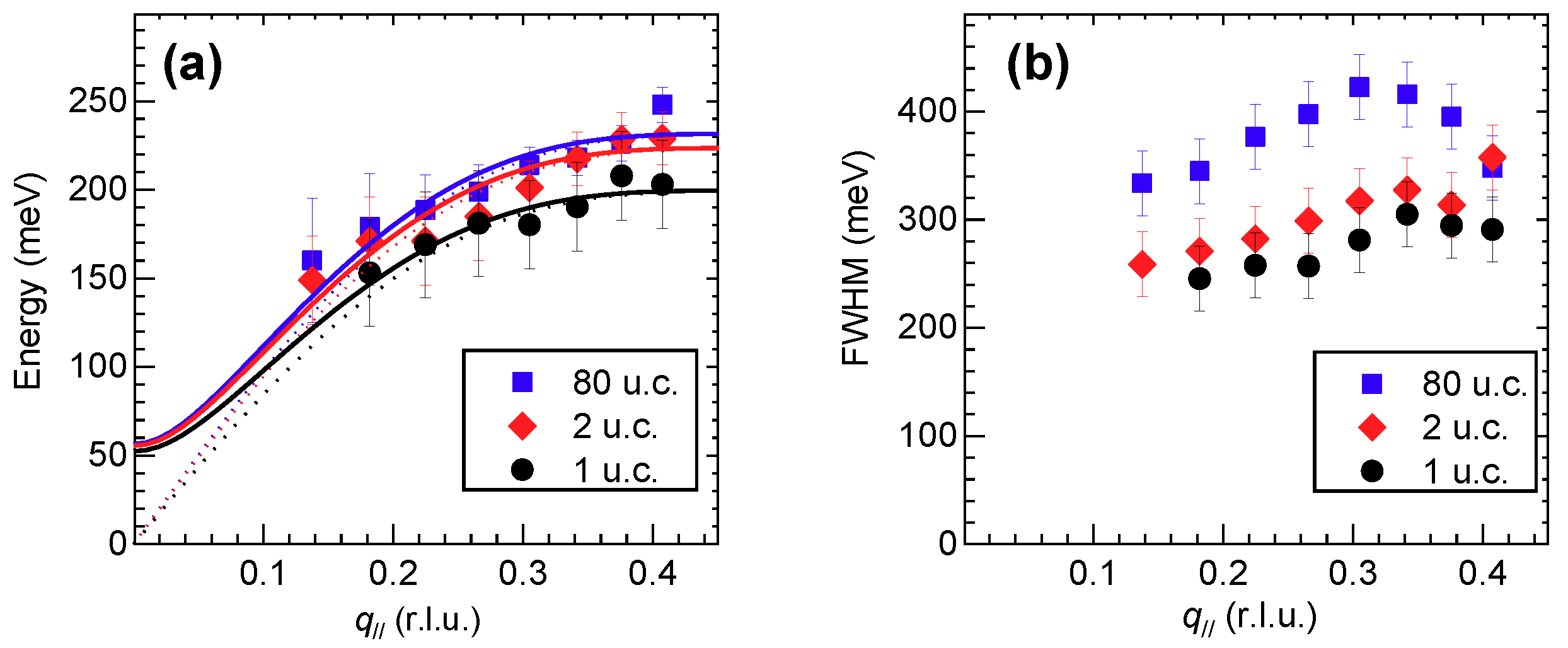
© 2020 by the authors. Licensee MDPI, Basel, Switzerland. This article is an open access article distributed under the terms and conditions of the Creative Commons Attribution (CC BY) license (http://creativecommons.org/licenses/by/4.0/).
Share and Cite
Moretti Sala, M.; Salluzzo, M.; Minola, M.; De Luca, G.M.; Dellea, G.; Srot, V.; Wang, Y.; van Aken, P.A.; Le Tacon, M.; Keimer, B.; et al. Structural, Electronic and Magnetic Properties of a Few Nanometer-Thick Superconducting NdBa2Cu3O7 Films. Nanomaterials 2020, 10, 817. https://doi.org/10.3390/nano10040817
Moretti Sala M, Salluzzo M, Minola M, De Luca GM, Dellea G, Srot V, Wang Y, van Aken PA, Le Tacon M, Keimer B, et al. Structural, Electronic and Magnetic Properties of a Few Nanometer-Thick Superconducting NdBa2Cu3O7 Films. Nanomaterials. 2020; 10(4):817. https://doi.org/10.3390/nano10040817
Chicago/Turabian StyleMoretti Sala, Marco, Marco Salluzzo, Matteo Minola, Gabriella Maria De Luca, Greta Dellea, Vesna Srot, Yi Wang, Peter A. van Aken, Matthieu Le Tacon, Bernhard Keimer, and et al. 2020. "Structural, Electronic and Magnetic Properties of a Few Nanometer-Thick Superconducting NdBa2Cu3O7 Films" Nanomaterials 10, no. 4: 817. https://doi.org/10.3390/nano10040817
APA StyleMoretti Sala, M., Salluzzo, M., Minola, M., De Luca, G. M., Dellea, G., Srot, V., Wang, Y., van Aken, P. A., Le Tacon, M., Keimer, B., Dallera, C., Braicovich, L., & Ghiringhelli, G. (2020). Structural, Electronic and Magnetic Properties of a Few Nanometer-Thick Superconducting NdBa2Cu3O7 Films. Nanomaterials, 10(4), 817. https://doi.org/10.3390/nano10040817





